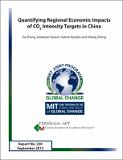| dc.contributor.author | Zhang, Da | |
| dc.contributor.author | Rausch, Sebastian | |
| dc.contributor.author | Karplus, Valerie | |
| dc.contributor.author | Zhang, Xiliang | |
| dc.date.accessioned | 2012-09-17T17:19:59Z | |
| dc.date.available | 2012-09-17T17:19:59Z | |
| dc.date.issued | 2012-09-01 | |
| dc.identifier.uri | http://hdl.handle.net/1721.1/73005 | |
| dc.description.abstract | To address rising energy use and CO2 emissions, China’s leadership has enacted energy and CO2 intensity
targets under the Twelfth Five-Year Plan (2011–2015), which are defined at both the national and provincial
levels. We develop a computable general equilibrium (CGE) model with global coverage that disaggregates
China’s 30 provinces and includes energy system detail, and apply it to assess the impact of provincial CO2
emissions intensity targets. We compare the impact of the provincial targets approach to a single national
target for China that achieves the same reduction in CO2 emissions intensity at the national level. We
find that at the national level, the national target results in 25% lower welfare loss relative to the provincial
targets approach. Given that the regional distribution of impacts has been an important consideration in the
target-setting process, we focus on the changes in provincial level CO2 emissions intensity, CO2 emissions,
energy consumption, and economic welfare. We observe significant heterogeneity across provinces in terms
of the energy system response as well as the magnitude and sometimes sign of welfare impacts. We further
model the current policy of fixed end-use electricity prices in China and find that national welfare losses
increase. Assumptions about capital mobility have a substantial impact on national welfare loss, while
assumptions about natural gas resource potential does not have a large effect. | en_US |
| dc.description.sponsorship | We acknowledge the support of the Ministry of Science and Technology of China through the
Institute for Energy, Environment, and Economy at Tsinghua University, and the support from
Graduate School of Tsinghua University, which is supporting Zhang Da’s doctoral research as a
22
visiting scholar at the Massachusetts Institute of Technology. We are also grateful for the support
provided by Rio Tinto China and Social Science Key Research Program from National Social
Science Foundation, China of Grant no. 09&ZD029. We further acknowledge the support of Eni
S.p.A., ICF International, and Shell, founding sponsors of the China Energy and Climate Project,
for supporting this model development work. We would further like to thank Dr. John Reilly, Dr.
Sergey Paltsev, Dr. Kyung-min Nam, Dr. Henry Chen, Paul Kishimoto and Tianyu Qi at Joint
Program on the Science and Policy of Global Change, and participants in the annual meeting of
China Energy and Climate Project and EcoMod 2012 Conference for helpful comments and
discussion.
23 | en_US |
| dc.language.iso | en_US | en_US |
| dc.publisher | MIT Joint Program on the Science and Policy of Global Change | en_US |
| dc.relation.ispartofseries | Joint Program Reports;230 | |
| dc.rights | An error occurred on the license name. | en |
| dc.rights.uri | An error occurred getting the license - uri. | en |
| dc.title | Quantifying Regional Economic Impacts of CO2 Intensity Targets in China | en_US |
| dc.type | Technical Report | en_US |
| dc.identifier.citation | Report 230 | en_US |
